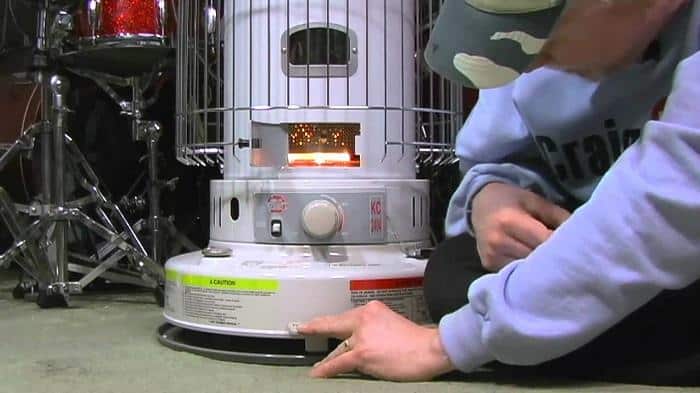No matter where you live and what the heat source for your home, you may encounter a time when you need a backup heater.
Portable kerosene heaters have many advantages. They store easily and are relatively inexpensive to use as a backup for an electrical outage or for when the wood for your fireplace or woodstove is too wet or scarce. They also burn fairly clean and can produce a good amount of heat for their size. And, the kerosene itself is easy to safely store. Some homesteaders even consider them the best type of backup heat.
There are two basic types of kerosene heaters you can use in your home — convective and radiant.
Usually circular in shape, convective kerosene heaters are designed for larger areas of your home. You should not use them for a bedroom or other small closed-in area. Convective kerosene heaters allow warm air to move upward and outward throughout the space.
A drawback of convective heaters is that they do not have removable fuel tanks and usually must be moved for refueling. Be sure to look for models that have a fuel gauge to make this process easier.
The Most Versatile Backup Stove In The World Allows You To Cook Anything, Any Time, Any Where [2]
Radiant kerosene heaters, on the other hand, usually are box-like or rectangular in shape. These heaters are designed for smaller areas, such as bedrooms. They have a wick, a combustion chamber and a reflector that allows you to direct the heat at certain spots of the room.
Most radiant models have a removable fuel tank, which makes refueling more convenient than with convective heaters. Some radiant models have electric fans to increase the flow of air, but, of course, this option will not do you much good in an electrical outage.
Follow All Warnings
Safety is one of the reasons many people are hesitant about using either form of kerosene heaters in their homes. Indeed, to minimize the risk of fire, you should use extreme caution in using kerosene heaters.
According to the National Fire Protection Association, supplemental heaters, such as kerosene heaters, are the leading cause of home fires during the winter months. On a year-round basis, supplemental heaters come second only to cooking equipment as the leading cause of home fires.
Here are some safety tips to keep in mind when using kerosene heaters.
- Use only 1-K grade kerosene for your heater. Do not use gasoline or another substitutes such as camp stove fuel. Other fuels can start a fire or cause an explosion.
- Use a heater that is tested, labeled and listed to have passed national safety standards.
- Match the square footage of the space you want to heat with the output of the heater.
- Place the heater on a level, protected surface where it is out of the way and will not be bumped into or knocked over.
- Purchase a heater that has an automatic safety shut-off device. This switch will snuff out the flame if the heater is tipped over, for example.
- Do not refuel an indoor kerosene heater when the heater is still hot. It is important to wait for it to cool.
- Do not move a lighted kerosene heater. If you need to move it, first extinguish the flame and then wait for the heater to cool before moving it.
- During heating season, check the wick on a weekly basis. Follow manufacturer’s directions for cleaning the wick.
- Since kerosene heaters have an open flame, they should not be used in a room where there are any other flammable solvents, such as aerosol sprays, lacquers or oils. Additionally, it is important to keep kerosene heaters a minimum of three feet away from furniture, curtains, clothing, bedding and other combustible materials, such as paper.
- If your children or pets touch part of an operating kerosene heater, it could result in a serious burn. Keep kids and pets away.
- Do not smoke around a kerosene heater.
- Clean any kerosene oil spills promptly. Spilled fuel is a fire hazard.
- Do not store kerosene in a container that has been used or could be used for other materials. Make sure the container is designed for kerosene storage and is appropriately marked as such. Blue containers are often used for kerosene.
In addition to the fire risk kerosene heaters pose, they also can pollute your indoor air, according to the U.S. Consumer Product Safety Commission. Carbon monoxide, sulfur dioxide, nitrogen oxides and formaldehyde are released into the air when kerosene heaters operate.
World’s Smallest Solar Generator … Priced So Low Anyone Can Afford It! [3]
These pollutants can build up in the home, if not monitored. One solution to this problem is to purchase a vented heater and to exhaust the gases outside through a wall in your home. If venting outside is not an option, do not use the heater in a closed space. A carbon monoxide detector would be a good investment.
If anyone in your family experiences dizziness, drowsiness, respiratory irritation or breathing difficulty when the heater is in operation, turn off the heater and move the family member where he or she can get some fresh air.
Finally, if your kerosene heater does ignite a fire, do not try to move or carry the heater. This movement could actually make the fire worse.
Instead, turn off the heater immediately. If this does not extinguish the fire, leave the house and call the fire department.
Portable kerosene heaters can be a great way to supplement the heat in your home this winter. When you follow proper precautions, they can add to your peace of mind that your family will be warm in an emergency.
Have you ever used kerosene to heat? Share your advice and tips in the section below:
Are You Prepared For Blackouts This Winter? Read More Here. [4]

